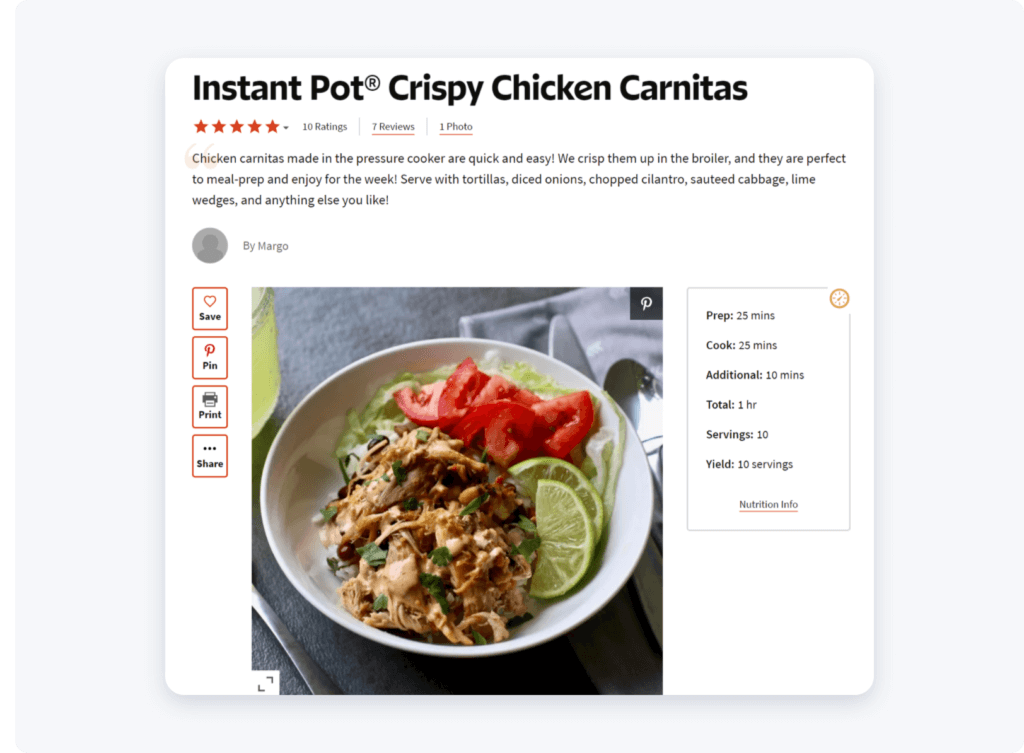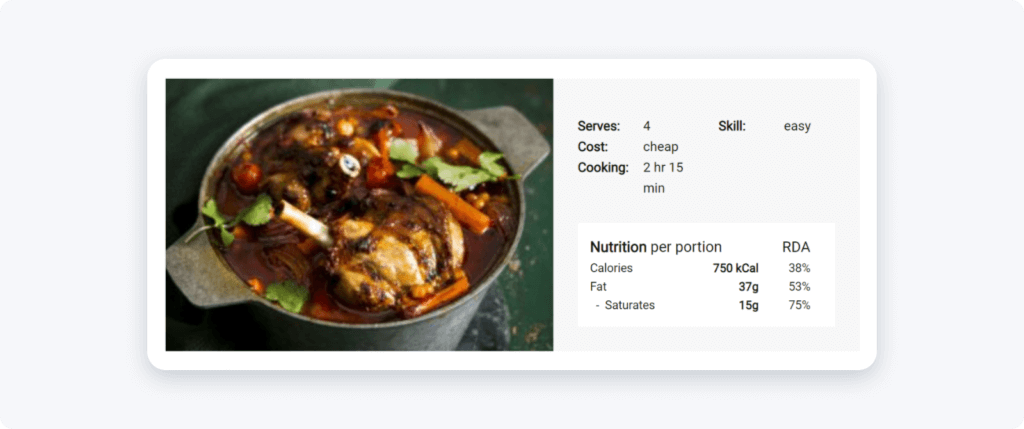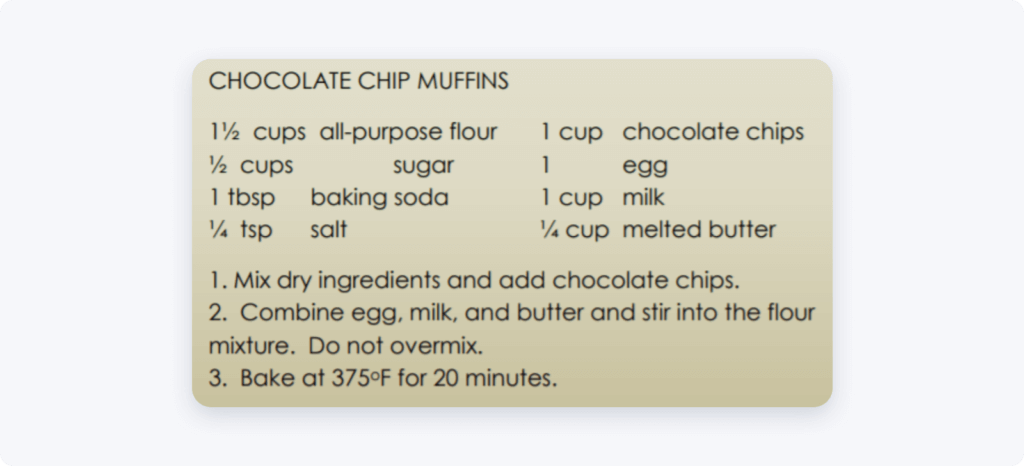In this extensive guide, we’ll give you all the information on how to write a recipe.
- Choose the right recipe format
- Use structured data for recipes
- Include the necessary elements in your recipe
- Partner with technology that does the heavy lifting
- How to create and optimize a recipe for SEO on Samsung Food
How to Write a Recipe that Helps Readers
Recipes are the main source of inspiration for home cooks. In 2020 alone, there was a whopping 45% increase in “recipes and cooking” video views. And Samsung Food users agree that recipes are crucial. A recent survey shows that three-quarters of our users cook or bake with recipes at least a few times a week.

So what goes into a good recipe? We asked our users. Eight out of ten Samsung Food users define a good recipe as one with easy-to-follow instructions. Other requirements include easy to make or replicate and a detailed ingredient list.

When it comes to recipes, clarity trumps all. Your recipe needs to follow a recognized structure that gives readers immediate access to all the important information while they cook.
The Basics: Get Started
First step, of course, is to write down the recipe. Test your recipe multiple times (experts recommend at least twice) and make copious notes. Finally, build a clear draft that has all the information to help your readers cook it at home. Arrange your recipe in a format that readers can easily follow.
Choose the Right Recipe Format
There are many different ways to write a good recipe. But there are three recognized formats that you’ll find on recipe websites, cookbooks, and other media.
Standard format
The standard format begins with a list of ingredients listed in the order of use. Following that, the instructions are listed step by step.
Active format
This format takes up plenty of space. The ingredient list appears within the recipe directions. This makes it harder for the readers to instantly check if they have the ingredients on hand.

Narrative format
In this format, the recipe is written as a paragraph. There’s no separate ingredient list. Instead, the ingredients are included within the method in the order of use. This format is ideal for short recipes with few ingredients.

The Best Recipe Structure: The Standard Format
The standard recipe format is the most commonly used — and for good reason. This format checks all the boxes when it comes to what users define as a “good recipe.”
- It’s easy to follow.
- It gives users a clear list of ingredients that they can quickly reference as they shop and cook.
- It makes it easy for the users to execute every step of the recipe as intended, as all the information is readily available.
- It’s the most SEO- and tech-friendly of the three.
Next, let’s explore what a well-written standard recipe looks like from the technical point of view.
The Technical Details: Help Your Readers Discover and Use Your Recipe
Now that you’ve written your recipe, it’s time to upload it somewhere so that your readers can find and cook it. And writing a recipe is only half the battle; it’s also important to structure and format it the right way.
When you search for “chicken piccata recipe” on Google, you easily get more than 4.6 million results. How is the search engine collecting these relevant results? And how can you make sure your recipe has the right foundation to come out on top (i.e., on the first page)?
This is where structured data and search engine optimization (SEO) and come in.
What is Structured Data?
Structured data is data that is organized into a clearly recognizable, standard format.
Structured data involves implementing a markup on your web page, which provides additional information about a page and classifies the page’s content. This enhances search engines’ understanding of the content. The better search engines understand the content, the higher the chances are that you will rank in search. For this markup to be consistently recognized and parsed by search engines, it needs to follow certain universal conventions.
Use Structured Data for Recipes
A web page with recipe content should follow a specific format that helps search engines recognize it as a recipe page. Structured data, in this case, is crucial information such as ingredients, cooking time, temperature, nutrition, and so on.
Platforms like Google and Samsung Food use microdata and microformat to add metadata to existing content. This metadata identifies the data mentioned above and pinpoints to automated systems that your content is a recipe.
When you provide these important information in the right format, search engines and other tech platforms like Samsung Food identify and better understand your recipe content. This helps them present your recipes to readers more easily and in visually appealing ways.
Some industry-standard microformats are hRecipe and Schema.
A sample recipe in Schema looks like this:

Using microformats on your recipe site can have significant benefits for recipe SEO. Structured data is not the only thing that helps your pages rank on Google’s search results. But it’s a great starting point.
Do not forget to format your mobile recipe pages as well.
Even though printed recipes remain common today, mobile content is slowly becoming just as critical.
When we asked our users how they read their recipes, we discovered that nearly 9 in 10 Samsung Food users use their mobile phones to read recipes while cooking.

This means your website must be optimized for smartphones and other mobile devices. Faster loading time and neat formatting to fit the mobile screen are critical to retain your readers.
So what do you include in your structured recipe? Let’s find out.
Include The Necessary Elements In Your Recipe
A standard recipe must contain the following data:
- Title
- Description
- Preparation and cooking time
- Number of servings and serving size
- List of ingredients with accurate measurements
- Step-by-step directions
- Accurate nutrition information
- Notes and FAQ
- Additional interactive features
When done well, this data also increases engagement and drives new traffic to your site.
Give Your Recipe an Effective Title
Your recipe’s title must be:
- Specific
- Descriptive
- Contain the most enticing and relevant keywords (texture, ingredients, techniques, etc.)
We found two effective titles that tell the reader exactly what to expect from the recipes.

Spicy Shrimp, Celery, and Cashew Stir-fry — the title tells you all you need to know about the recipe. It even lets you visualize the final dish.

Chicken carnitas is a popular dish. But this chicken carnitas recipe makes sure to hook your attention with the title.
The important thing to note here is that the recipe writer did not swap the “chicken carnitas” part of the title with something else. Even with its unique features, it’s still a chicken carnitas recipe. A reader who’s looking for Instant Pot, crispy chicken, or Latin American recipes will land on this page. But then, so would someone who’s looking for a chicken carnitas recipe.
Quick Tip: Try to visualize the title and any other subtitles in terms of HTML. Apart from improving search results, headings and subheadings (H1-H6) on your recipe page organize the content and help your readers scan quickly to find the most relevant parts first.
Provide Preparation and Cooking Times
When you add preparation time and cooking time to the beginning of your recipe, it gives the home cook a clear idea of how much time they need before they get the meal on the table.
These are the two things you need to include in your recipe:
- Preparation time: time needed to get the ingredients in order before cooking.
- Cooking time: time needed for the actual cooking process after preparation is complete.
Give Number of Servings (Yield) and Serving Size
Your recipe for cookies must tell the reader how many cookies are in a batch. Just as in the ingredient list, this needs precise measurements. Ensure that an individual portion size is reasonable.
Brownie points if you use a dynamic serving calculator that lets your reader easily scale the recipe up or down!

The Korean Vegan’s Kimchi Soondooboo Chigae recipe comes with a handy and printable recipe card.
- This recipe serves 4.
- When you change the number of servings (1x, 2x, or 3x), the ingredients dynamically change.
- When you click on Print Recipe, you can change the recipe servings to even more exact quantities (like 11).
Hook Your Readers with an Evocative Description
Also known as “romance copy,” this is the short hook that informs and persuades the reader. In a rich search result, this supports the title (and accompanying image) with interesting additional information.
An effective description gives the reader a snapshot of the key ingredients and encourages them to take action.

This spicy coconut chicken and noodle soup recipe has a short but inviting description that hits all the right notes.
List Your Ingredients in the Right Order
Here are some important pointers that help your recipe do well in terms of SEO, readability, and with tech algorithms:
- Separate your ingredient list from the method.
- Every ingredient appears in the same order as it does in the recipe execution.
- Each ingredient gets its own line.
- Give accurate measurement for every ingredient with the right units.
- Give exact preparation of ingredients in the list instead of cluttering the recipe (e.g., “cooked and drained chickpeas”)
- Be specific with ingredient names. (e.g., “canola oil” instead of “oil”)

This five-ingredient raspberry honey flapjacks recipe is successful in putting together a simple ingredient list.
- Each line is dedicated to only one ingredient.
- It specifies exact measurements for ingredients — and remains consistent.
- Where there’s flexibility, the recipe is transparent about the choices the writer made. It’s clear from the list that you can use any honey, but they made the recipe with heather honey.
- The ingredient list is specific. It tells you to use light brown soft sugar and frozen raspberries, not just “sugar” and “raspberries.”
Give Clear, Specific Directions
Effective step-by-step instructions are precisely structured.
- The method must list each step in the order in which it occurs in the execution.
- Every step must be as detailed as possible.
- It must contain key information like oven or stove temperature, duration of marinating, etc.

The instructions in this Italian-American sausage and peppers bowl recipe captures all the steps thoroughly while also remaining concise.
- The steps are listed in the exact order you’d go about executing them.
- Every step tells you exactly what you need to do with specific details — when you should execute a step (“once onions and peppers are soft”), specific heat (“medium heat”), and how to serve the dish, for instance.
- It’s clear and uncluttered. It gives you just the right amount of information in simple language, without meandering and jargon.
Include Accurate Nutrition Information
Nutritional data is another way to get Google to notice your recipe. But more importantly, this information helps your readers prioritize their health and dietary needs. You can perform this nutritional analysis using the USDA database.

Even a simple nutrition table like the one from this lamb shanks recipe goes a long way in informing the readers what they’re getting from the recipe.
Quick Tip: Use Samung Food’s free Recipe Nutrition Calculator to unlock detailed nutritional information for any recipe.
Address Readers’ Questions with Notes and FAQ
Anticipate readers’ questions and concerns and answer them in a separate notes section. This is another form of structured content that would bump up your recipe in the search results as “helpful” to readers.
Here are some things you can include notes for:
- Storage instructions
- Possible substitutions
- “Best before” date
- Allergy and avoidance information
- Food and beverage pairings
Include Additional Interactive Features
Readers expect to do more with recipes than just read and follow them. Some useful functionalities include:
- Save
- Share
- Shop ingredients
The right recipe structure acts as a strong foundation upon which you can build these features without friction.
Partner with Technology that Does the Heavy Lifting
Instead of manually building out recipes for your website, you can rely on technology to do it. You don’t have to figure out the individual moving parts by yourself, like optimizing the desktop and mobile versions or calculating accurate nutritional values. An AI-powered platform could greatly simplify these tasks for you.
There are some advantages to using a tech platform like Samsung Food for Recipe Creators:
- It automates most of the tedious tasks, so you can save time and focus on creating recipes.
- It keeps track of all the moving parts and takes care of the complicated processes.
- You don’t have to manually update your content to keep up with changes in the industry and technology.
- With the right technology, you can elevate your recipes with thoughtful additions that engage readers, like personalized recommendations.
- You get access to advanced analytics and insights like the latest trends, better understanding of your target demographic, and evolving content categories (coming soon).
How to create and optimize a recipe for SEO on Samsung Food
Want to learn how to effectively fill out our recipe builder and optimize it for SEO? Follow the steps below!
Recipe Text
Title Section
- Use Clear, Descriptive Titles: Choose a title that clearly describes your meal, including the main ingredient or cuisine type. For example, “Hearty Beef Stew with Root Vegetables” instead of just “Beef Stew”.
- Incorporate Keywords: Use relevant keywords that people are likely to search for. Conduct keyword research using SEO tools to find the best terms.
- Keep it Concise: Be descriptive. But keep the title concise so that it doesn’t get cut off in search engine results.
Description Section
- Engage your Readers: Write a compelling introduction to your recipe. Mention your meal’s origin, special qualities, and/or any interesting personal anecdotes about your recipe.
- Include Keywords: Naturally integrate primary and secondary keywords within the description.
- Highlight Unique Aspects: Mention what sets your recipe apart, such as “gluten-free,” “no added sugar,” or “ready in 20 minutes”, “keto friendly”.
Image and Video Section
Adding Images
- Choose High-Quality Images: Select high-resolution images that best present your recipe. Ideally, include images of your finished meal, key steps in preparation, and ingredients.
- Use Descriptive File Names: Instead of default camera file names like “IMG_1234.jpg,” rename your image files to include relevant keywords, such as “easy-chocolate-chip-cookies-final.jpg”.
Adding Videos
- Create Engaging Videos: Produce a video that walks viewers through your recipe process. Keep it engaging and concise!
- Video File Name: Like images, add relevant keywords to the name of your video file’s name. For example, “easy-chocolate-chip-cookies-final.”
Ingredients Section
- List Ingredients Clearly: List all ingredients in order of use. Be specific about quantities and states. For example: “1 cup chopped onions” rather than “onions”.
- Use Common Names and Variants: Include commonly searched terms and possible ingredient variants. For example “coriander or cilantro”.
- Optimize for Long-Tail Keywords: Where relevant, use long-tail keywords like “organic raw honey” instead of just “honey.”
Instructions Section
- Step-by-Step Format: Break down your instructions into clear, numbered steps.
- Use Action Verbs: Start each step with an action verb, such as “combine,” “whisk,” “fold,” etc.
- Integrate Keywords: If there are steps that are unique to your recipe, try to naturally integrate keywords. For example: “Sear the grass-fed steak on high heat.”
- Choose High-Quality Instruction Images: Select high-resolution images that represent your recipe well. Ideally, include images of key steps in preparation, and ingredients. Add devices, utensils and ingredients for each step.
Servings and Prep-Cook Time Section
- Prep time: Input the exact preparation and cook time needed before cooking begins. Prep time includes chopping, marinating, etc.
- Cook Time: Enter the time it actually takes to cook your recipe after prep. If there are different stages, give a total time.
- Serving Size: This is the average amount of food that is typically eaten at one time. For example, if a recipe’s serving size is “4,” this means that your recipe should produce enough food to serve four individuals. Knowing the serving size is essential for nutritional information calculations. It can also be useful for meal planning and portion control.
Community Collection Section
Categorize: Assign your recipe to a fitting collection such as “Healthy Meals” or “Weeknight Dinners”. It’ll make it easier for people in our community to find it.
Final Thoughts
The art of recipe writing may be difficult to master, but it’s definitely not impossible to get right. Today’s recipe content ecosystem is rapidly growing and incredibly competitive. To have an edge over other content creators and make your recipes your audience’s go-to, you need to not only write an amazing recipe but also optimize it for both readers and technology. However, the process of setting up your recipe website doesn’t have to be as daunting as it looks. With an AI-powered solution like Samsung Food for Recipe Creators, you can automate most of the tedious tasks, monetize your content, and gain deeper insights that will guide your content strategy.


